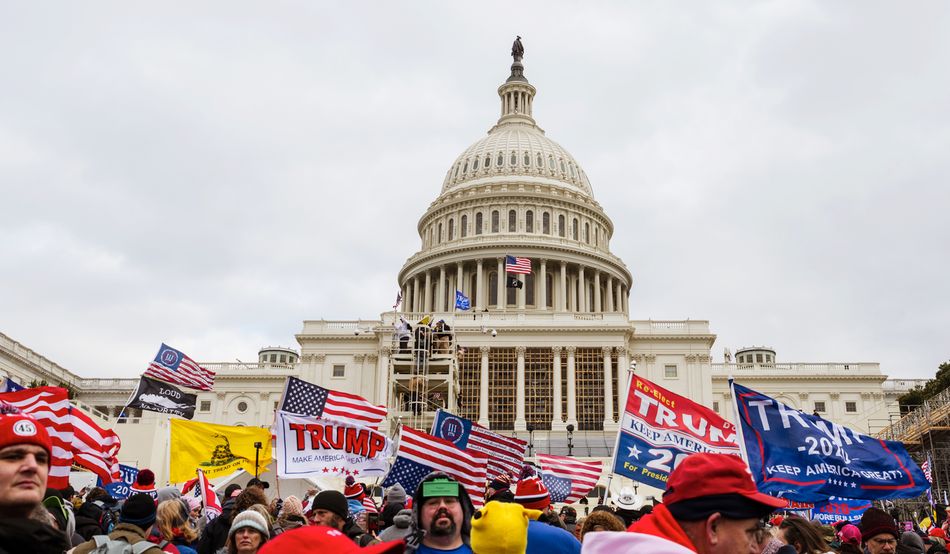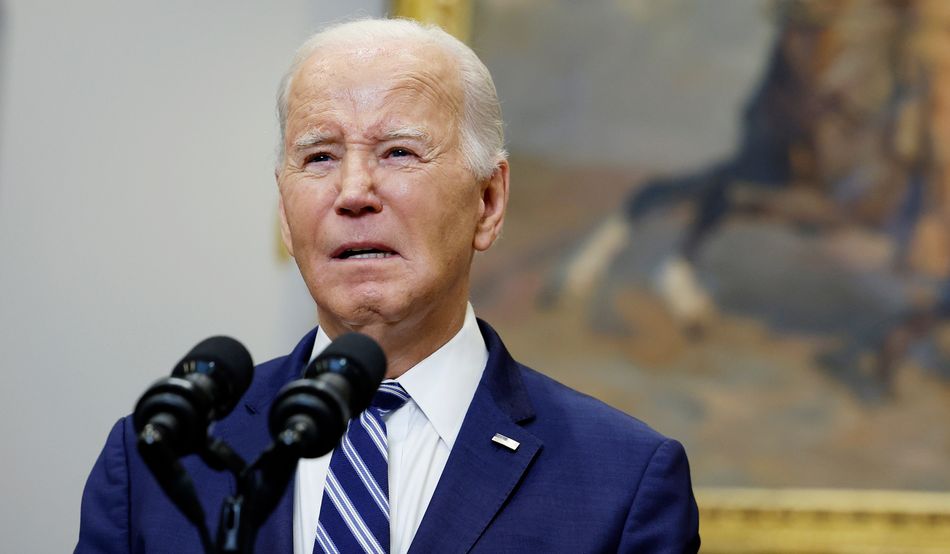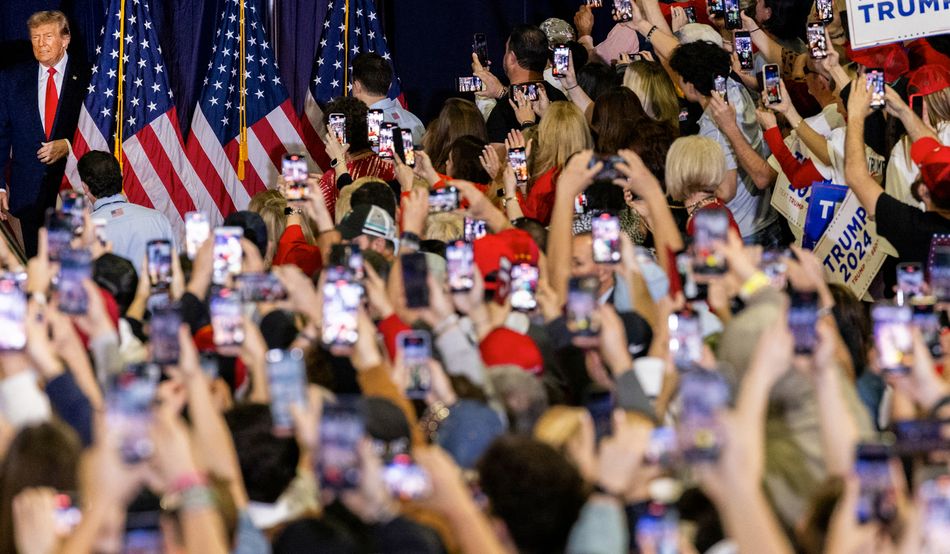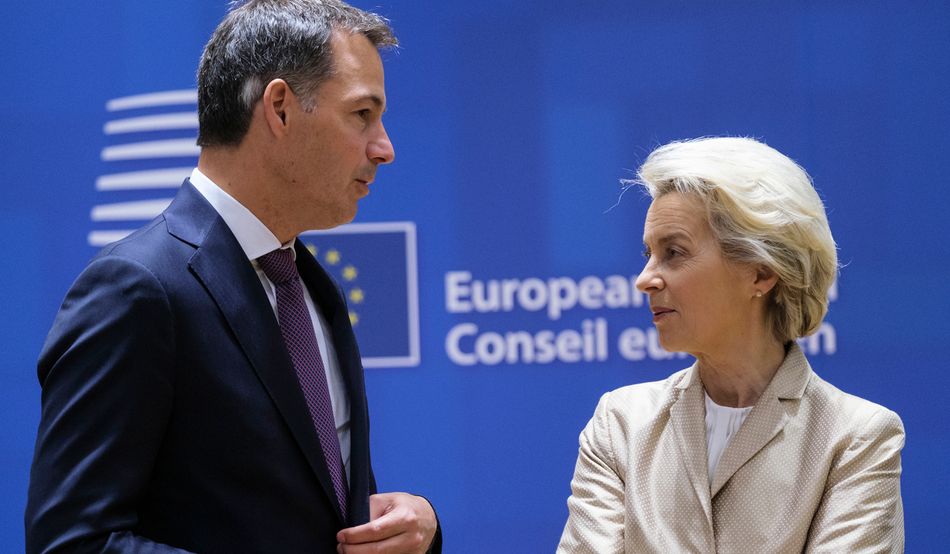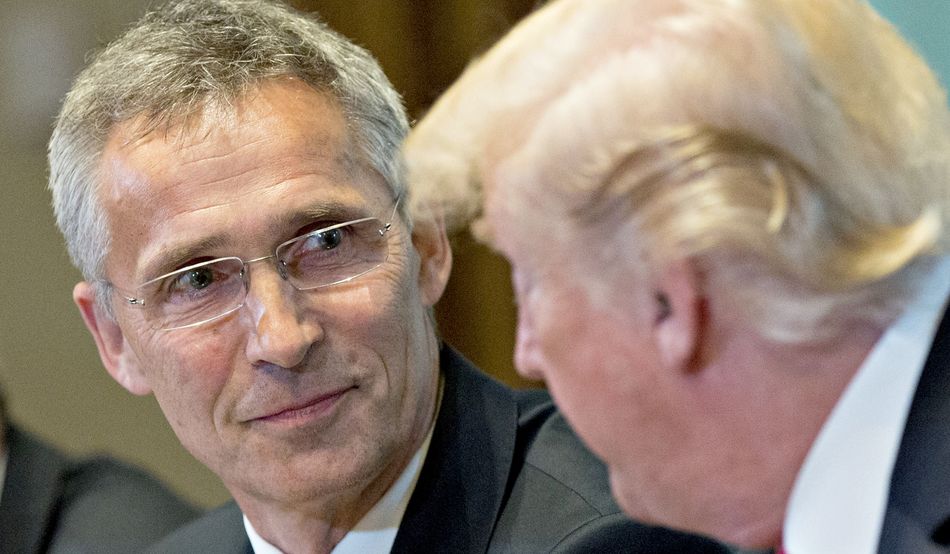Those of us who are horror film fans know that it can be a lonely pursuit, involving late nights in front of the television while the rest of the household retreats. The genre includes a lot of repetitive dross, but, at its best, it can be real art, as richly creative as anything in cinema. And when I saw the acres of newsprint that followed Donald Trump’s crushing victory in the Iowa caucus in January, much of it on the agitated side of overwrought, I was irresistibly reminded of the words of Pennywise, the malevolent, shape-shifting, reality-bending clown in the 1990 film of Stephen King’s novel It: “I’m every nightmare you’ve ever had. I am your worst dream come true.”
So will Trump’s Second Coming really take him all the way back to the White House? My answer would be somewhere between possible and likely. He has the Republican nomination nailed down, barring a personal catastrophe. For what it is worth at this early stage, he is ahead of Biden in the opinion polls in the marginal states. There are some media reports suggesting that young voters, a demographic that previously shunned Trump, are flocking to his banner. Well, perhaps. But there are also reasons why Trump may come up short. Here, briefly, are some of them.
First, Trump is the most divisive politician in America. He attracts extraordinary loyalty; he is less a politician than a cult leader, with followers rather than supporters. But that fanatical base is not enough. Trump also turbocharges the Democrat turnout; Biden secured more votes in his 2020 victory than any candidate in history, beating his opponent in the popular vote by no less than seven million. In particular, Biden won “independents”—voters not affiliated to either of the two main parties. And while the top line from the recent New Hampshire Republican primary was Trump’s 11-point victory over Nikki Haley, the underlying message was that he remains unpopular outside his base: Haley won independents by 58 per cent to 39 per cent. Add to this a Trump campaign largely based on greatest hits and grievances rather than the future, and it’s not obvious which new voters he will win over to turn 2020’s defeat into victory.
Then there are Trump’s legal troubles. He’s just been fined $450m and banned from doing business in New York for three years for falsifying his business accounts. Next in the pipeline are four major criminal cases, amounting to 91 separate indictments. These comprise the “New York hush money” allegations about undisclosed payments to adult film star Stormy Daniels in violation of campaign finance law; the classified documents case about hundreds of papers found at Trump’s Mar-a-Lago resort; the 6th January case about Trump’s efforts to overturn the 2020 election result; and the Georgia allegations about Trump personally pressuring the chief election officer in that state to “find” him 11,780 votes. The Trump legal team will try to delay all of these beyond the election. But two of the trials are currently set for March and one for May. At the very least, Trump will spend much of the next few months in court. At worst, one of the trials will end in a conviction before the Republican Convention in July. Trump will of course appeal. But polls suggest that a significant number of his own supporters—24 per cent, according to one recent New York Times poll—will not vote for Trump if he is handed a conviction. This is essentially why Haley is staying in the race: it’s the “something might turn up” strategy.
Third, Biden might start to do better. His personal ratings are underwater essentially for two reasons: voter disappointment with the US economy, and worries about his age. There is nothing much he can do about the latter, unless one of the Silicon Valley technocrats invents a fountain of youth. But on the economy, the US is doing much better than the market analysts had been predicting: Europeans would be dancing in the streets if they were matching US figures. US GDP grew at a 3.3 per cent annual rate in the final quarter of 2023. Inflation is dropping, manufacturing investment is up, consumer spending is solid and predictions of recession in 2024 are being rewritten as fast as analysts can get to their keyboards. Indeed Jerome Powell, chair of the Federal Reserve, said in February that the US job market and economy were strong and that interest rates might be cut three times through 2024. If the key to election victory is, as Bill Clinton’s strategist James Carville said, “the economy, stupid”, then the cavalry may be appearing.
The risk of terrorist attacks on European soil would rise
And finally, Trump is showing his age, too. In 2016 his energy levels were inexhaustible, his campaigning relentless and his resilience unquenchable. This time round, he looks heavier, his voice has aged, and his energy levels have dropped. And, like the other candidates in this presidential race, he is showing signs of “cognitive decline”. He sometimes forgets where he is, or muddles names. In one recent speech he tore into Haley for supposed security failings during the 6th January attack on the Capitol. He meant Nancy Pelosi.
That said, perhaps Trump is beyond this kind of analysis. This is an individual who, thanks to his multi-annual starring role in The Apprentice, occupies a unique position in the Venn diagram of popular culture; the place where the three circles of politics, business and celebrity intersect. This is the president who suggested people should inject disinfectant to combat Covid; who wanted to buy Greenland; who reportedly proposed using nuclear weapons to deflect hurricanes; and who reacted to losing the 2020 election by trying to subvert American democracy. That ought to be enough counts against anyone. But there is a Terminator-like indestructibility to Trump; it feels as though he is always going to be with us. And to repeat, he could, may even be likely to, win this election.
So what would a Trump 2.0 look like? On domestic policy, if Trump’s campaign speeches and videos are an accurate guide, it will be four years of mayhem. Revenge will be taken, grievances will be settled, the government bureaucracy will be heavily politicised, the US Army will be despatched to stop illegal immigration across the southern border, and oil and gas drilling will be expanded. But the focus here in Europe will be on foreign policy, and in particular on a handful of questions: what will a Trump administration do about Ukraine, about Gaza, about relations with China, about climate change, about Nato and about relations with the UK and Europe?
On Ukraine, Trump has said that he would stop the war “in 24 hours”. The details of how he would accomplish this are yet to be described. But the plan seems to amount to ending US military supplies to Ukraine, compelling Zelensky to strike a deal, any deal, with Putin.
If this is right, the only deal imaginable is one in which Russia would keep at least all of the land it has captured since the invasion, more than 15 per cent of Ukrainian territory: it is inconceivable that Putin would settle for less. This would be bad enough. But it would only mark a pause in the conflict, not the end. Putin would use the time to replenish Russian forces and prepare to take Kyiv and install a client government there. This, after all, has always been Putin’s objective, as his original invasion plan demonstrated, and as his ally, former president Dmitry Medvedev, has recently reaffirmed. So ending military supplies to Ukraine would likely lead to a devastating defeat for the west: Putin would have profited from his invasion by grabbing a significant chunk of Ukraine, and would be poised to threaten other parts of Europe. And that’s without factoring in the signal that this outcome would send to China in relation to its ambitions for Taiwan.
What about the conflict in Gaza? During his presidency, Trump recognised Israeli sovereignty over Jerusalem and the Golan Heights; he moved the US Embassy from Tel Aviv to Jerusalem; he announced that Israeli settlements in the West Bank did not contravene international law; he triggered a break in relations with the Palestinian Authority; he halted US funding for UNRWA, the UN agency responsible for Palestinian refugees; and he closed down the Palestinian Representation in Washington.
Against this background, and if the Israeli ground operation in Gaza were still under way at the start of 2025, it is a stretch to imagine a Trump administration pressing Israel to minimise civilian casualties in Gaza, or to end the ground operation quickly. It is, moreover, equally difficult to see Trump pressing Israel to commit to a new process to negotiate a two-state solution. And in the absence of consistent US pressure, it is improbable that Israel, deeply divided and traumatised by the events of 7th October, would launch such a process itself.
This points to a continuing tense deadlock in Gaza and the West Bank, with the two million Palestinians displaced from their homes in Gaza living in camps, supported by aid agencies, and renewed conflict possible at any moment. The west would continue to face a torrent of criticism from the Arab world and the Global South for its failure to improve the situation or resolve the Palestinian issue. Iran would carry on exploiting the situation, and might step up its support for extremism across the region. The Houthis would go on harassing international shipping in the Red Sea, prompting much of it to take the long way round. Hezbollah would keep making trouble on the Israel-Lebanon border. And the risk of terrorist attacks on European soil would rise.
On China, Trump has said relatively little since he started campaigning. There are, however, clues from his first term. In 2018, he launched a trade war with China which, combined with wider protectionism, amounted to an $80bn tax increase on $380bn worth of exports to the US. It is arguable whether the policy delivered. Some authoritative US economists argue that such tariffs are effectively paid by US consumers through higher prices and US businesses through higher costs. A study published in January 2021 by the US-China Business Council concluded that the US economy shed 245,000 jobs as a result of the policy. Nevertheless, the Trump campaign team is suggesting that, if Trump wins, tariffs of 60 per cent plus will be imposed on China.
Trump’s views on Taiwan are more of a mystery. Chinese premier Xi Jinping has said that China’s reunification with Taiwan is “inevitable”, and habitually declines to rule out using force. When Trump was asked on Fox News last July whether, as president, he would come to Taiwan’s aid in the event of a Chinese attack, he declined to answer. Though he added somewhat bizarrely that “Taiwan did take all of our chip business… we should have tariffed them.”
Some respected analysts think Trump is simply indifferent to Taiwan. “During the majority of the Trump administration,” said Evan Medeiros, a senior member of the National Security Council staff under Barack Obama, “one of the worst kept secrets in Washington was that Trump didn’t care about Taiwan.” John Bolton, Trump’s national security adviser for 17 months, recalls in his memoir one incident in the Oval Office when Trump made clear just how little importance he attached to the smaller nation. He pointed to the tip of his favoured Sharpie pen and said, “This is Taiwan,” then pointed to the famous presidential desk and said, “This is China.” And the Chinese regime has noticed. One of its spokesmen said recently that “the US will always pursue America First and Taiwan can change from a chess piece to a discarded chess piece at any time.”
So what does this mean for a second Trump term? A renewed trade war with China looks likely, however ineffective and damaging to the US economy it might be. That would have a wider disruptive effect on global trade. But on Taiwan, Xi may see an opportunity. A full invasion isn’t likely; it would be high risk, the Chinese military is not up to it (yet), and the inevitable western sanctions would do considerable damage to China’s export-led economy, which is recovering from a period of disappointing growth. But other forms of Chinese pressure—such as a naval blockade—are conceivable. We could see a ramping up of military incursions into Taiwanese waters and airspace alongside ever louder public threats
and intimidation.
Why would this matter to the rest of the world? Taiwan is a crucial part of global supply chains. A single Taiwanese company, the Taiwan Semiconductor Manufacturing Company, makes more than half of the world’s silicon chips, and 90 per cent of the most advanced types. These chips power everything from mobile phones to aircraft control systems to supercomputers. The world needs more than a trillion chips a year: imagine the damage to the global economy if supply was disrupted.
Trump intends to impose a 10 per cent tariff on all imports—potentially leading to a global trade war
On climate change, Trump has form. During his first term he took the US out of the Paris agreement, appointed fossil fuel lobbyists to environmental agencies and predicted that global warming would soon spontaneously reverse. On the campaign trail for 2024, he has promised to let fossil fuel production rip; to “drill, drill, drill”. And he would presumably again take the US out of the Paris deal (Biden having rejoined it in 2021).
The US is second only to China as a contributor to global CO2 levels, so an American president championing large-scale fossil fuel production would in itself be damaging. But perhaps the greatest impact would be psychological. To reach net zero in greenhouse gas emissions by 2050, emissions need to be reduced by 45 per cent by 2030. Notwithstanding the efforts made at successive COP conferences, the international community is well short of this target: on present trajectories, emissions will have actually increased by almost 9 per cent between 2010 and 2030. Getting to where we need to be will require a genuinely global effort and real sacrifices, especially among the largest polluters like China, India and the EU. The chances of this happening if the US has opted out of the system are much reduced, perhaps even non-existent.
As for Nato, Trump has previously described it as “obsolete”, calling its members who aren’t spending 2 per cent of GDP on defence “delinquents” and hinting that he doesn’t accept Article 5 of the Nato treaty—the principle that an attack on one is an attack on all. And in a campaign rally in South Carolina on 10th February, he said that, as president, he would encourage Russia “to do whatever the hell they want” to any Nato country that didn’t meet the spending guidelines—a comment the White House described as “unhinged”. Added to this, the French EU commissioner Thierry Breton revealed in January that, in a private meeting with president of the European Commission Ursula von der Leyen in 2020, Trump said: “You need to understand that if Europe is under attack we will never come to help you and support you.” He continued by saying: “By the way, Nato is dead and we will leave.” Bolton himself has said in an interview that he is “convinced [Trump] will withdraw from Nato”.
In the face of this, some commentators have taken comfort from the fact that senators added a bipartisan provision to the defence bill they passed in December 2023, asserting that no president could take the US out of Nato without approval from the Senate. But this is to misunderstand the essence of Nato, which is the commitment to collective defence. As Ivo Daalder, a former US ambassador to Nato, has pointed out, no one, not even Congress, can force an American president to defend another nation with the full might of the US military. And if there isn’t complete confidence in the US commitment to Article 5, Nato becomes less a military alliance, more an exercise in bluster. In these circumstances, and in a future world where Putin had already annexed even more of Ukraine thanks to the ending of US military support, it is not a stretch to imagine Putin looking at the Baltic states as the next phase in his re-creation of the Soviet Union.
So for Europe, the future of the US in Nato will be the dominant preoccupation in the event of a second Trump term. But it won’t be the only story. Trump is no admirer of the EU, once describing it as “worse than China” in its treatment of the US. He is, moreover, essentially a believer in protectionism: in his first term, apart from launching a trade war with China, he imposed a 25 per cent tariff on US steel imports and a 10 per cent tariff on aluminium imports. Should he win in 2024, Trump intends to impose a 10 per cent tariff on all imports, including those from Europe, with the supposed objective of incentivising American domestic production. This proposition has been underreported in Europe, but would be profoundly disruptive. There would almost certainly be EU, and wider, retaliation, potentially leading to a global trade war. Some respected US economists believe the policy and its fallout would reduce the size of the US economy by 1 per cent, while smaller, more vulnerable economies around the world might shrink by far more.
As for the UK, there is no evidence from Trump’s first term that we would receive any sort of special treatment, whichever party captures Number 10 in the next election; Trump is not sentimental about the “special relationship”. And whatever the recent positive noises about a UK-US free trade deal during a Trump 2.0 presidency, there should be no illusions about the price the US would demand for this: virtually unfettered access for US industrial farming products to the UK market, hormone-treated beef included. Try asking the National Farmers’ Union what they’d think about this. So we are likely to face the same challenges as the rest of Europe—though without the retaliatory capability provided by being a member of the world’s largest trading bloc. Come January 2025, we might just feel rather isolated.
All of which leads to the question: what should we be doing to prepare for a second Trump presidency? Here are some ideas.
Ukraine is the likeliest first transatlantic crisis of a Trump return to the White House. Whatever the uncertainties about Trump’s attitude towards Nato, few doubt that he would stop US military aid to Ukraine. Indeed, Maga Republicans in Congress, egged on publicly by Trump, are already blocking the next consignment. So the objective is to use the next 10 months to get Ukraine in the best possible shape to survive, whatever 2025 brings. At the moment, the largest military donor to Ukraine by far is the US. If it pulls back, Europe is unlikely to be able to fill in for everything, but it should be able to do much more than at present. The first priority will be ramping up European production capacity. This will mean approaching Europe’s military industries and asking them to prepare for substantially increased production, especially of basics like shells and ammunition. This needs to start now.
Second, on the assumption that the Biden administration can overcome the deadlock in Congress, we should encourage the US to pre-position and stockpile supplies for Ukraine in central European Nato member states: once the supplies are there, they are unlikely to be taken back, whatever the election outcome.
Third, there should be something for Ukraine at the Nato summit in Washington this coming July. It isn’t going to be an accelerated path to membership: there is substantial opposition to this around the Nato table, led by Germany. But it could be an offer of practical assistance in the work that Ukraine has to do to meet the criteria for membership.
Fourth, European ministers should be visiting Congress whenever they are in the US and making the case for continuing military support for Ukraine. There is, ultimately, a cross-aisle majority in Congress for this.
On Gaza, the reality is that the UK has little to no influence over Israeli actions or policy. Nor do other European nations. The only country with real influence is the US. Even here there are limits: ultimately, Netanyahu feels able to defy American pressure when he chooses, as his current positioning demonstrates.
Nevertheless, the priority here has to be around making things happen before the US election, on the basis that after it, if Trump has won, all pressure on Israel might disappear. So the UK should be supporting the Americans in pressing for a quick end to the ground operation in Gaza. We should be planning for the aftermath: how do we encourage a new Palestinian leadership, because it cannot be Hamas; who will govern Gaza and oversee reconstruction; is there a security role for the international community, whether on Israel’s borders or in Gaza? And we should, in coordination with Washington, be talking to our Arab friends about the parameters of a two-state solution, how to get negotiations restarted, and in particular, what incentives and assurances Arab countries might be able to offer to draw Israel into negotiations. Normalisation of relations between Saudi Arabia and Israel, on which the Americans are already working, is one of the elements here.
On China, the main risk is of being pulled in two opposing directions. We have our own commercial and economic interests with China. We also have our own criticisms of Chinese policies and behaviour. But we are not in perfect alignment with the US, even with the Biden administration. The gap will be bigger with Trump in the White House. We will come under pressure to join in American policies, whether imposing tariffs, or excluding Chinese firms from participation in our infrastructure projects, or limiting the number of Chinese students in our universities. There will be some difficult choices, which carry costs whatever we decide. We will need to have thought through where our balance of interests lies. In short, we need a strategy.
On climate change, I suggest there are three priorities in a Trump presidency. The first is to stick to our own net zero plan and resist the temptation to use US backsliding to weaken our commitments. The second is, as far as possible, to ensure that the rest of the world sticks to the commitments they have made at successive COP conferences, whatever the Americans are doing. And the third is to work with individual US states on climate change, as we have done in the past. Under the US federal system, states have the powers to pursue green policies whatever the position at federal level, and some are big enough to make a difference. California, for example, if a country, would be the fifth largest in the world in terms of nominal GDP, ahead of India.
On Nato, the picture that Trump 2.0 would inherit is very different from the 2016 landscape. Back then only five member states were spending 2 per cent of GDP on defence. By the end of 2024, notwithstanding Trump’s recent tirade on countries’ underspending, Nato insiders estimate that 20 member states should have reached the figure. Some of this is down to war in Europe. But it has to be recognised that some of it is down to the pressure that Trump applied during his first term.
At the core of this is Germany. At their first meeting in 2017, Trump reportedly presented former German chancellor Angela Merkel with an invoice for hundreds of billions of dollars, supposedly representing the amount the US had spent over the decades protecting Germany. Both sides denied the story, but relations between Merkel and Trump were clearly frosty. By contrast, Germany has now overtaken the UK as the second-biggest defence spender in Nato.
In the light of this, if I were advising Jens Stoltenberg, the secretary general of Nato who developed a reputation as a Trump-whisperer during Trump’s first term, I would be urging him to open up a private channel to the president’s team—perhaps to the man personally—in order to get across three messages.
The objective is to get Ukraine in the best possible shape to survive—whatever 2025 brings
First, things have changed dramatically in terms of European defence spending. This opens the way to Trump asserting a personal triumph at the first Nato summit of his second term, claiming that his leadership has brought about the biggest transformation in defence spending in a generation, even if he would still like Nato allies to go further. The Europeans should agree publicly that this spending was down to Trump.
Second, Stoltenberg should try to persuade Trump that there is simply no benefit for Trump personally in being drawn into public comment on the principle of collective defence—whether the US would always, sometimes, or never come to the support of a Nato member under attack. The relevant treaty article is actually ambiguous on what exactly allies are obliged to do in terms of support: that ambiguity should be left intact.
Third, Stoltenberg should remind Trump that the US defence industry earned $120bn from defence sales to Nato allies through 2022 and 2023. Those sales would go elsewhere if the US opted for isolationism. And meanwhile, if I were an official in any prime minister’s office around Europe, I would be commissioning the experts in government to start doing some contingency thinking about how a Nato without the United States would look and function—just in case.
There are two further, broader, lessons for us in this. The first is that, despite Brexit, if Trump is back in the White House in 2025, we will need to get closer to Europe—because there won’t be an American wing under which to shelter. Trump doesn’t see the world in terms of alliances and friendships. To the extent that he has a worldview, it is one of big power relationships; the world should be sorted out through deals between him, Putin and Xi.
Alexander De Croo, the prime minister of Belgium, recently expressed the problem with a minimum of diplomacy but admirable clarity: “If 2024 brings us America First again, it will be more than ever Europe on its own… [Europe must become] stronger, more sovereign, more self-reliant.” And if we are to avoid lonely mid-Atlantic isolation, we will need to have developed the structures and relationships through which we can consult, coordinate and—where necessary—act with Europe, whether it is retaliating to trade tariffs or sharing the burden in supporting Ukraine or working together to save the international response to climate change. This may not sit easily with the aspirations of Brexit, but the world will have moved on.
Second, it feels as if European governments have been taken by surprise by the possibility of Trump returning to the White House; a sudden lurch from complacency to panic. It shouldn’t be like this. It was clear from the day after he lost that Trump would run again. It was equally clear that his fanatical base would not move on. History tells us that the US periodically detaches itself from the world: the non-interventionism of the 19th century, the isolationism of the 1930s. And every serious foreign ministry has a team focused on anticipating and planning for future problems. We should have seen this coming, and been contingency planning all this time rather than scrambling in election year. One more from the horror film lexicon, this time from Freddy Krueger: “You shouldn’t have buried me. I’m not dead.”

